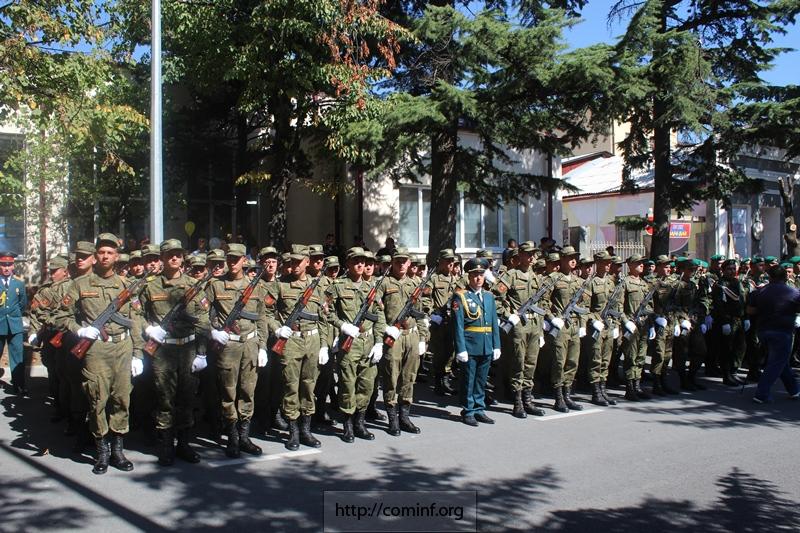Russia lays groundwork for South Ossetia Annexation

Ambassador Yelchenko was referring to March 14 decree signed by President Vladimir Putin signed that will see the armed forces of Georgia’s breakaway region of South Ossetia integrated into the Russian military command structure in two ways: some detachments will join the Russian military base, while the remaining “armed forces of South Ossetia” will be organized on Russian Army’s pattern and tasked under Russian supervision.
The initial batch of 150 servicemen will join the Russian military base in the coming days and weeks. They, as well as those who will follow, would retain their military rank. The South Ossetian troops will be reduced by the number of servicemen that would join the Russian base. The files of the South Ossetian servicemen that join the Russian base will be assigned to the military commissariats of Russia’s North Ossetia.
The remaining South Ossetia troops (their exact number is unclear) will adopt the new rules of engagement and operating procedures subject to Moscow’s approval. In addition, the objectives and structure of the forces will be determined in agreement with Moscow in peacetime as well as in times of conflict. Salaries and social benefits of the South Ossetian servicemen will also be covered by Russia.
When combined, the two elements of the decree would practically make all South Ossetia troops either formally integrated, or practically run under Russian control.
Tbilisi condemned the decision as illegitimate. But its legal status notwithstanding the move directly impacts Georgia’s national security as well as the security of the region.
Massive militarization
Russia’s recognition of South Ossetia and Abkhazia regions as independent states after 2008 war was followed by dramatic militarization of both regions. Currently, Russia stations an estimated 4,500–5,000 military in each Abkhazia and South Ossetia. Border guards, subordinated to Russia’s Federal Security Bureau (FSB) and other paramilitary units are also present, with their number estimated 1,200-1,300 in each of these regions.
The Russian bases are equipped with offensive military gear, such as tanks and long-range artillery, including multiple rocket launch systems (MLRS), as well as sophisticated anti-access systems, such as S-300 antiaircraft batteries (NATO reporting name SA-10 Grumble).
In 2011, the two separatist governments of Abkhazia and the Tskhinvali have signed an agreement allowing Russia to operate its military bases in both regions at least for 49 years. While the Russian deployments violate the commitments that Russia made in the cease-fire agreement with Georgia in 2008, Moscow argues that the recognition of the two states has created ‘a new reality’ of the new states inviting Russian troops, so that the cease-fire provisions are no longer relevant.
The recent decision of Russia is being rebuked by Georgia’s Western allies as a step towards further assimilating Tskhinvali and Sokhumi into Russia both politically and militarily.
Even though Russia has de facto controlled both regions for almost a decade now, it has kept a formal pretense of treating them as an independent states, not as integral parts of Russia. But with signing of the comprehensive “Treaties on Alliance and Integration” with both in 2015, and the practical measures that have followed, the pretense of independence becomes ever harder to maintain.
Georgia regards the “treaties” as a starting point for annexation of the two regions by Russia. The “merger” – in fact, absorption – of the separatist military formations into Russian military structures is one of the most tangible elements of this process.
In the meantime, Tskhinvali will hold ‘presidential elections’ on 9 April. Their outcome might pave the way to a referendum over its unification with the Russian republic of North Ossetia or with Russia as a separate republic. These scenarios are embraced by two main contestants– current leader Leonid Tibilov and the speaker of the legislature Anatoly Bibilov.
Larger chessboard
The move from Russia further reduces already fragile prospects of conflict resolution. Formalizing Russia’s dominance in Tskhinvali’s political and military affairs will embolden those voices in Tbilisi, that say Tskhinvali de facto authorities are Russia’s puppet regime, and cannot act as the real counterparts in conflict resolution efforts with official Tbilisi.
But there local implications are only one dimension in what is a larger chessboard of Russia’s confrontation with the West and the NATO in particular.
Recently uncovered additional deployment of S-300 batteries to Abkhazia (first deployments were reported as early as in 2009) is likely to be mirrored in Tskhinvali region. Similar to the deployments in Russia’s Kaliningrad exclave, the extensive deployment of anti-access/area denial (A2/AD) hardware is likely to be shadowed by the deployment of aggressive first strike systems, such as Tochka-U (SS-21 Scarab) short-range ballistic missile systems (some sources suggest Tochka-U systems were deployed as early as in 2011). All of these fall within Russia’s declared intent to counter NATO’s increased focus on the Black Sea region.
In this sense, whether and when the Kremlin would decide to annex South Ossetia would depend on wider international dynamics, rather than narrowly linked to Russia’s policy towards Georgia and the South Caucasus. The gradual integration lays the groundwork for the annexation, when it happens, it would be just a formal act of political showmanship.
Zviad Adzinbaia is Master of Arts in Law and Diplomacy candidate at the Fletcher School of Law and Diplomacy, focusing on International Security Studies.